Lately, I’ve been reading more and more about protein, how our guidelines were set for it, and specific amino acids and their roles in health (especially during pregnancy and early childhood).
Proteins are quite literally the building blocks of human life. Every cell in your body contains protein and you require the amino acids in protein to build new cells.
As you can imagine, there are a lot of new cells being created during pregnancy, making protein an absolute necessity to supply your growing baby (and your growing uterus and other tissues) with the raw materials to carry out the job effectively.
The last 20 years has seen a huge leap in understanding of protein and amino acid needs, particularly in pregnancy. Using a method known as the indicator amino acid oxidation method (IAAO), we’re now able to safely quantify needs for protein (and even individual amino acids aka the “building blocks of protein”) in different stages of pregnancy.
Suffice to say, we now have a lot of re-education to do around protein, especially when it comes to pregnancy! Not only has my clinical/personal/anecdotal experience with higher protein intakes in pregnancy shown it to be beneficial, but we now have a lot of white paper research to support it. I’m not the first person to come to this conclusion and I won’t be the last.
The question is how long will it take for our guidelines to catch up?
It’s often assumed that protein intake in “developed” countries is adequate or even too high. However, a 2021 study questions this in regards to protein intake during pregnancy, highlighting the importance of getting this research out there. Before I get to that, let’s talk about protein requirements in pregnancy.
How much protein do you need in pregnancy?
If you search online for “protein requirements in pregnancy” you’ll find mixed answers.
If you go by the dietary guidelines, you can define protein needs by a gram amount per body weight — this is called the recommended daily allowance (RDA). The current RDA for pregnancy is 1.1 g per kg of body weight after the first trimester (first trimester protein needs default to non-pregnant requirements for adult females of 0.8 g/kg).
Or, you can go by the acceptable daily macronutrient range (AMDR), which is given as a percentage of calories consumed. This results in a wide range of “acceptable” protein intake ranging from intakes close to the RDA to intakes that are more than triple the RDA. The AMDR for pregnancy is 10-35% of calories.
Finally, there are blanket statements, like “pregnant women need ~71 grams of protein per day” or “pregnant women need an extra 25 grams of protein per day in the third trimester.”
Generally, the most accepted standard for protein requirements is the RDA, however protein researchers point out that the RDA is set at a bare minimum level and it’s likely that optimal protein intake is much higher than the RDA.
As I explain in chapter 2 of Real Food for Pregnancy, the dietary guidelines for pregnancy were set with almost no data on pregnant women. Shocking, I know.
Protein Requirements in Pregnancy are Higher Than Previously Thought
The first ever study to directly measure protein needs in pregnant women (circa 2015) found that true protein needs were 39% higher in early pregnancy and 73% higher in late pregnancy compared to the estimated average requirement. They found the estimated average requirement (EAR) should be set at 1.22 g/kg in early pregnancy and 1.52 g/kg in late pregnancy.*
Since nutrient requirements are calculated based on prepregnancy weight, this means a woman who started her pregnancy at 150 pounds would need 83 g of protein in early pregnancy and 104 g of protein/day in late pregnancy to meet this updated EAR.
For simplicity’s sake, let’s just round it to >80 g in early pregnancy and >100 g in late pregnancy.
*Additional food for thought for nutrition nerds: An EAR is always lower than the RDA, so if we were to set a new RDA for pregnancy based on this research, it would be 73% higher than 1.1 g/kg, or approximately 1.9 g/kg in late pregnancy.
Are you eating enough protein during pregnancy?
Recently, a study reported on usual protein intake among a nationally-representative sample of U.S. pregnant women and compared it to both the current guidelines and the new “optimal” intakes identified by that 2015 study.
Of note, 40% of 2nd trimester mothers and 67% of 3rd trimester mothers fell below optimal intake levels, averaging only ~82 g protein/day.
Optimal intake would be a minimum of ~100g/day (more if you’re a larger person or very active).
The researchers note that “pregnant women were more likely to meet the trimester-specific protein RDA as their percent protein intake from animal sources increased.” In fact, ⅔ of protein intake was met by animal foods.
Protein-rich foods
Below are some high-protein foods. For reference, one ounce of meat or one egg provides about 7 g of protein.
- Beef, lamb, pork, bison, venison, etc. (ideally from pasture-raised animals)
- Chicken, turkey, duck, and other poultry (ideally from pasture-raised birds)
- Fish & seafood (ideally wild-caught)
- Sausage & bacon (ideally from pasture-raised animals)
- Organ meats (liver, heart, kidney, tongue, etc.)
- Homemade bone broth or stock (or powdered gelatin or collagen protein)
- Eggs (ideally from pasture-raised hens)
- Cheese (ideally from grass-fed or pasture-raised animals)
- Yogurt (Greek yogurt is especially high in protein and low in carbohydrates)
- Nuts: Almonds, pecans, peanuts, walnuts, hazelnuts, pumpkin seeds, sunflower seeds, cashews, etc.
- Nut butter, such as peanut butter or almond butter
- Beans, peas, lentils and other legumes
How is eating more protein in pregnancy beneficial?
As I always point out, protein-rich foods are also naturally rich in many micronutrients required in higher amounts during pregnancy (B12, choline, zinc, iron, vitamin A, etc.). When you meet your protein needs (assuming an omnivorous diet), you’re also likely to meet vitamin and mineral needs from food as well. I recommend consuming a balance of animal-sourced and plant-sourced protein as they have unique nutritional profiles and benefits.
In addition to providing numerous micronutrients, protein is the most satiating macronutrient (prevents cravings and overeating). Protein does not tend to raise blood sugar. When consumed in the context of a mixed meal that contains carbohydrates, it vastly improves the body’s glycemic response, since it doesn’t directly raise blood sugar but does stimulate the release of insulin (this makes it key for gestational diabetes management).
In fact, one of the most common problems I identify in challenging gestational diabetes cases is insufficient protein intake. When we correct that, women spontaneously tend to reduce their intake of carbohydrates slightly (due to increased satiety) and have much better overall glycemic patterns. I can see this first hand in blood sugar logs, especially in cases where they are wearing a continuous glucose monitor.
Even in women without gestational diabetes, getting enough protein is very helpful. Once we increase dietary protein, a lot of other “issues” tend to self-resolve. This is especially true when enough protein is consumed at breakfast. A protein-sufficient breakfast sets you up for a day of fewer blood sugar swings and stable energy levels. Read my classic post, “the healthy breakfast mistake,” for more on this, as this applies to everyone at all stages of life, not just during pregnancy.
Lastly, sufficient protein intake is needed to support the many vascular changes that occur in pregnancy. Your body is tasked with handling about 50% increased blood volume and your entire vascular system has to adapt as a result. Sufficient protein intake, especially from amino acids found in collagen-rich foods, is key here. This is why higher protein intakes seem to be particularly beneficial for the prevention and treatment of preeclampsia and for mitigating swelling in late pregnancy.
Note: If you’re familiar with the Brewer’s diet, one of the main principles was higher protein intake. Though I don’t agree with everything about the Brewer’s diet, the protein recommendations turned out to be pretty much spot on. If you have concerns about preventing or treating preeclampsia with diet, see the section on “high blood pressure” in Ch 7 of Real Food for Pregnancy.
Specific Amino Acids & Their Role in a Healthy Pregnancy
In addition to awareness around total protein intake, I believe there needs to be greater discussion around specific amino acids and how they support prenatal health and fetal development.
Before I jump into this, let’s define amino acids.
Proteins are made of smaller components called amino acids. There are 20 standard amino acids, all with different functions in your body. Some protein foods contain a mix of all of them (we call these complete proteins), while others contain only a selection (incomplete proteins). Once your body digests proteins into individual amino acids, it can rebuild new proteins within the body for various metabolic processes.
Foods of animal origin or “animal foods” — such as meat, fish, eggs, and dairy — are complete proteins. Plant foods — such as beans/legumes, nuts, and seeds — are incomplete proteins. Although consuming a combination of incomplete proteins can meet essential amino acid needs, it takes far more calories from plant foods to meet these needs when compared to animal proteins. This may explain why vegetarians tend to eat less total protein than omnivores.
With rising interest in plant-based and vegan diets, discussing the roles of individual amino acids has become even more important. Some amino acids, which are plentiful in animal foods, are low or entirely absent from plant foods. In situations where plant foods are providing the majority of protein intake, concerns arise over consumption of sufficient amino acids.
These concerns extend beyond the amino acids termed “essential,” a quandary that even many nutritionists and dietitians are completely unaware of. More on this in a minute.
Essential amino acids & non-essential amino acids
Every so often, I come across research that makes me question everything that I was ever taught.
In school, we learn that some of the amino acids are “essential,” meaning your body cannot make them (rather you must consume them in your diet), while others are “non-essential,” meaning your body can make them from other amino acids (and thus there’s no need to eat them).⠀⠀⠀⠀⠀⠀⠀⠀⠀
However, research into the functions of individual amino acids has exploded in the past few decades and some say that non-essential amino acids (NEAAs) is “a misnomer in nutritional sciences and should no longer be used.”
That’s right: There’s no such thing as non-essential amino acids
I mean it. The concept of non-essential amino acids is scientifically unproven. And yes, I was just as shocked as you are to learn this.
It turns out that “extensive studies indicate that animals and humans cannot adequately synthesize NEAAs to meet optimal metabolic and functional needs under either normal or stress conditions.”⠀⠀⠀⠀⠀⠀⠀⠀⠀
Many functions of NEAAs cannot be achieved by essential amino acids. This includes: neurotransmission, regulation of acid-base balance by the kidneys, creation of bile acids, antioxidative reactions in retinal cells, heart, and skeletal muscle (particularly by taurine), conversion of folate to tetrahydrofolate in one-carbon metabolism, creation of glutathione (the liver’s main detoxification enzyme), creation of thyroid hormones, and dozens of other functions.⠀
Many examples of this are true in regards to prenatal nutrition, where amino acids like glycine and taurine become “conditionally essential,” meaning you must consume them directly from your diet during pregnancy for your body to adapt optimally to the metabolic demands of pregnancy and to support your baby’s growth and development. This is a huge, overlooked topic, especially for folks who do not eat adequate amounts of protein or who don’t include protein from a variety of sources and therefore certain amino acids can be lacking or entirely missing from the diet.⠀⠀⠀⠀⠀⠀⠀⠀⠀
Until nutrition science catches up to define the needs of amino acids more clearly, I strongly encourage an omnivorous diet. This is the time-tested way to check all the boxes for your micronutrient needs, as well as all amino acids, whether “essential” or “non-essential.”
With all that said, let’s dive into the roles of several amino acids — one essential and the rest “non-essential” — and how they support a healthy pregnancy.
Lysine and pregnancy
Lysine is an essential amino acid, so it’s widely accepted that we must obtain it in sufficient amounts from food sources for our bodies to function properly. Lysine is required for the formation of collagen, a protein that helps support and give structure to skin and bones. Low lysine intake is linked to lower immune function, increased anxiety, poor GI function (oftentimes diarrhea), and a reduced ability to produce/maintain collagen.
Research on pregnant women from 2018 found that “current dietary lysine recommendations during late stages of pregnancy may be underestimated.” That’s because the current DRI for amino acids for pregnancy are “set by applying a single multiplying factor to the nonpregnant amino acid recommendations.” In other words, they are a guesstimate, as are many of the nutritional guidelines for pregnancy.
This newer data — the first ever to assess lysine needs in pregnancy — suggests the current DRI for lysine is set 23% too low to meet the demands of late pregnancy (3rd trimester).
This is right in line with the aforementioned 2015 study that determined the DRI for protein in late pregnancy is grossly underestimated.
The good news is if you meet your protein needs from a variety of sources, including animal foods, you’re unlikely to fall short in lysine. However, the authors of the lysine study specifically warn that those on a vegetarian and vegan diet are at risk for insufficient lysine intake.
Foods that are richest in lysine include eggs, Parmesan cheese, chicken, bacon, bison, lamb, beef, venison, turkey, pork skin (chicharones), salmon, spirulina algae, and parsley.
Taurine and pregnancy
Taurine is the most abundant amino acid in our bodies and is a “conditionally essential” amino acid, meaning the body can make plenty of it from other amino acids under normal circumstances. During pregnancy, however, taurine needs increase beyond what your body can typically supply, hence the term “conditionally essential.”
Taurine is crucial for normal fetal beta-cell development (the cells that make insulin in the pancreas), insulin action, brain development, eye development (retinal photoreceptor activity), reproduction, normal growth development, and antioxidant activity. High concentrations of taurine have also been noted in the uterine fluids of women during the luteal phase of menstrual phase (the 14 days following ovulation), suggesting that taurine may also play a role in pre-implantation embryo development.
A taurine deficiency in pregnancy may affect glucose metabolism in utero, increasing risk of type 2 diabetes in adulthood, and has also been linked to intrauterine growth restriction. In a 2020 study of pregnant mothers and their neonates, mothers who had the highest taurine intake (> 120 mg, average intake was 104.2 mg) had neonates with significantly higher weight and height at birth.
Plasma taurine has been found to be significantly lower in women who have had gestational diabetes and there is some research showing an increased risk of gestational diabetes with low plasma taurine.
In fact, a 2021 study was the first cohort study to investigate the association of maternal plasma taurine levels with gestational diabetes risk. The researchers found that lower plasma taurine in early pregnancy (first trimester) was a reasonable indicator of an insufficient insulin secretion and therefore, was associated with a higher risk of gestational diabetes development in pregnant women who had already given birth to one or more children.
Taurine is also involved in bile acid conjugation and can increase the expression and activity of bile acid synthesis, which are key regulators of glucose, lipid and energy metabolism in pregnancy. Abnormalities of bile acid regulation in pregnancy may lead to intrahepatic cholestasis of pregnancy (ICP), a serious condition associated with several fetal and maternal morbidities. Patients with cholestasis commonly experience intense itching with associated skin lesions. One of the most predictive and accurate markers for diagnosis and follow up of ICP is decreased glycine/taurine bile acid ratio (< 1.0).
Taurine deficiency should be of concern if you follow a vegetarian/vegan diet. This is because taurine is pretty much absent from most plant foods. Foods that are highest in taurine include animal products like shellfish (like scallops and mussels), salmon, liver, dark meat from chicken, turkey, and beef, lamb, most dairy and eggs.
Glycine and pregnancy
Like taurine, the amino acid glycine is commonly glossed over in conventional nutrition because it is also “conditionally essential.” During pregnancy, however, glycine needs increase beyond what your body can typically supply, making it “conditionally indispensable.”
The only way to keep up with this demand and avoid deficiency is to obtain glycine from the diet. Glycine is an important component of collagen (making up approximately one third of collagen). And 1/3 of all the protein in your body is made up of collagen. This may explain why, traditionally speaking, so many cultures place an emphasis on gelatin/collagen-rich meals that utilize the tough cuts of meat (with lots of connective tissue), bones, and skin.
Glycine turnover is incredibly high in pregnancy, both for maternal and fetal demands. Fetal DNA, bones, connective tissue, internal organs, blood vessels… you name it, it requires glycine.
Glycine is important for baby, but is also important for expecting mothers. Your uterus at term contains 800% more collagen than in a non-pregnant state. Your skin, which has to stretch to an unimaginable capacity, needs glycine in order to do so. Your liver needs glycine to synthesize its major detoxification enzyme, glutathione. And your circulatory system needs more glycine to maintain normal blood pressure and to accommodate all the extra fluids of pregnancy (this is why some research suggests it may help prevent preeclampsia). If you want to keep your joints happy, reduce your risk of stretch marks, help your perineum stretch without tearing (or heal properly if that happens), you need to be eating an adequate amount of glycine.
Glycine also plays a key role in methylation (a biochemical process involved in a wide range of body functions, and is crucial to maintaining our overall health), much like folate, choline, and vitamin B12.
This is why glycine-rich foods in pregnancy and postpartum are incredibly important. Like the aforementioned amino acids, including enough of this amino acid on a diet that excludes animal foods is challenging. The fact that our prenatal nutrition guidelines make ZERO mention of glycine is one of their most significant oversights.
The best way to obtain glycine in the diet are to consume the connective tissues, skin, and bones of animal foods, like you would when eating bone broth, slow-cooked meat (like pot roast and stews), chicken with the skin, pork cracklings (fried pork skin), and collagen or gelatin powder. Insufficient intake of glycine is of significant concern for both vegetarians and vegans since concentrations of this amino acid are generally low in plant foods. Of the plant food sources, spirulina algae is one of the best, though the quantity required to meet glycine demands is likely unfeasible.
Proline and pregnancy
In some ways, proline is like glycine in that it’s not considered an essential amino acid and yet plays a vital role in pregnancy/fetal health (though, unlike glycine, it is not studied enough to classify it as conditionally essential during pregnancy). It tends to be found in the same foods as glycine, since it’s also a major component of collagen (there are a few exceptions here; see below).
Proline is involved in differentiation of cells (including embryonic stem cells) and overall embryonic growth/development. It’s crucial for the synthesis of polyamines in the small intestine and placenta (polyamides are key regulators of DNA and protein synthesis, among other functions). Polyamine concentrations in the placenta are especially high in early pregnancy when the organ is growing rapidly (aka being formed from scratch).
Research from animal models suggests that proline is vital to fetal growth (suggesting it may play a role in intrauterine growth restriction). It also happens to be the most abundant amino acid in mammary milk (it appears to be synthesized within the mammary gland itself to further boost milk concentrations).
There remain a lot of unanswered questions, especially since studies on human pregnancies are extremely difficult, but it appears wise to make sure your diet contains adequate proline.
In general, animal proteins contain 3–6x more proline than plant proteins per gram. The richest food sources are gelatin/collagen, pork rinds, cheese (esp Parmesan, cottage cheese, and Swiss), organ meats, cabbage (esp savoy cabbage), poultry, wild game, beef, and spirulina algae.
Carnitine and pregnancy
Carnitine is another “conditionally essential” amino acid in pregnancy, meaning that its synthesis from other amino acids is insufficient to meet demands. Therefore, once again, diet plays the most important role in ensuring needs are met.
Carnitine is critical for the transfer of long-chain fatty acids into the mitochondria for β-oxidation, a process that ultimately turns fatty acids into ATP (the body’s main source of energy). However, during fasting, carnitine may increase fatty acid production to ketones (a back-up energy source), which may be used by the brain for energy production under fasting conditions. In pregnancy, the “switch from fatty acid oxidation takes place more rapidly under fasting conditions than in non-pregnant state, probably due to increased fetal demands.” As you can see, for the mother, carnitine is crucial to sustain energy metabolism during pregnancy.
Levels of carnitine continuously decline as pregnancy progresses and it’s important to note the research suggests inadequate iron status may impair carnitine synthesis. Low enough levels, (along with glycine) may also increase risk for gestational diabetes.
Carnitine is critical in fetal growth, and insufficiency has been linked to preterm birth (PTB), low-birthweight infants, and IUGR in the fetus. It is also essential for fetal-placental fatty acid oxidation and for the production of energy after birth in the neonate. In fact, carnitine is stored in fetal tissues in increasing amounts during the last part of gestation because babies need it to produce their own ketones for energy. Thus, maternal carnitine status is vital to ensuring an adequate supply to her baby.
Carnitine has also been found to have protective effects against lipid peroxidation (a process where free radicals interact with fatty acids in a way that results in cell damage). It also assists in the conversion of α-Linolenic acid (ALA), an omega-3 fatty acid into another form, docosahexaenoic acid (DHA), which is important for fetal brain development. (Side note: a dietary source of DHA is still required, as conversion of ALA to DHA is insufficient to meet the high demands of both pregnancy and breastfeeding.)
Pregnant women who are vegetarians/vegans are at risk for low carnitine since it is found exclusively in animal foods (the prefix “carn” refers to meat). Foods that are highest in carnitine are red meat (like beef steak or ground beef; in fact, a general rule of thumb is “the redder the meat, the higher the concentration of carnitine”), whole milk, cheese, fish and poultry.
Take home message about protein needs in pregnancy
Protein and their individual amino acids play a huge role in pregnancy health and outcomes, as well as in fetal growth and development. We’ve covered some of the “essential”, “conditionally essential” and “non-essential” amino acids (though recall that the concept of non-essential amino acids is still scientifically unproven).
When conventional prenatal nutrition guidelines are taken at face value, which assume that our bodies are able to synthesize enough of any so-called non-essential amino acids from other amino acids, many women end up with suboptimal levels during pregnancy. This is especially true if their interpretation of meeting their protein needs is consuming only enough to meet the RDA, which is much too low!
Newer research has clarified that sufficient intake of a wide range of amino acids (and higher protein intake, in general) is optimal for maternal and fetal health.
Luckily, if you consume an omnivorous diet with protein intake in the newer recommendation range for pregnancy, you likely won’t have to worry if you’re getting enough of any particular amino acid. That’s the beauty of real food. It takes the guesswork out of it.
If you think you may be consuming a lower-protein diet or if you specifically exclude most or all animal foods from your diet (i.e. are vegetarian or vegan), hopefully this new data will help you make an informed choice on some dietary modifications for optimal pregnancy outcomes.
Until next time,
Lily
PS — Do you like this type of in-depth information on prenatal nutrition? If you don’t already have a copy of Real Food for Pregnancy, now’s the time to give it a read! This post contains excerpts from the book. Paperback, ebook, and audiobook are available. I want you to have an informed, empowered, and healthy pregnancy!
References
- Elango, Rajavel, and Ronald O. Ball. “Protein and amino acid requirements during pregnancy.” Advances in nutrition 7.4 (2016): 839S-844S.
- Pencharz, Paul B., Rajavel Elango, and Robert R. Wolfe. “Recent developments in understanding protein needs–How much and what kind should we eat?.” Applied Physiology, Nutrition, and Metabolism 41.5 (2016): 577-580.
- Allès, Benjamin, et al. “Comparison of sociodemographic and nutritional characteristics between self-reported vegetarians, vegans, and meat-eaters from the NutriNet-Santé study.” Nutrients 9.9 (2017): 1023.
- Payne, Magdalene, et al. “Lysine requirements of healthy pregnant women are higher during late stages of gestation compared to early gestation.” The Journal of nutrition 148.1 (2018): 94-99.
- Liu, Peng Ju, et al. “The relationship between plasma taurine levels in early pregnancy and later gestational diabetes mellitus risk in Chinese pregnant women.” Scientific Reports 11.1 (2021): 1-9.
- Jung, You-Mi, and Mi-Ja Choi. “Relation of Taurine Intake During Pregnancy and Newborns’ Growth.” Advances in experimental medicine and biology vol. 1155 (2019): 283-292. doi:10.1007/978-981-13-8023-5_27
- Casslén, B G. “Free amino acids in human uterine fluid. Possible role of high taurine concentration.” The Journal of reproductive medicine vol. 32,3 (1987): 181-4.
- Hultman, Karin et al. “Maternal taurine supplementation in the late pregnant rat stimulates postnatal growth and induces obesity and insulin resistance in adult offspring.” The Journal of physiology vol. 579,Pt 3 (2007): 823-33. doi:10.1113/jphysiol.2006.124610
- Norberg, S et al. “Intrauterine growth restriction is associated with a reduced activity of placental taurine transporters.” Pediatric research vol. 44,2 (1998): 233-8. doi:10.1203/00006450-199808000-00016
- Zhu, Bo et al. “Characteristics of bile acids metabolism profile in the second and third trimesters of normal pregnancy.” Metabolism: clinical and experimental vol. 95 (2019): 77-83. doi:10.1016/j.metabol.2019.04.004
- Kroumpouzos, George. “Specific dermatoses of pregnancy: advances and controversies.” Expert Review of Dermatology 5.6 (2010): 633-648.
- Singh, G, and K Sidhu. “Cholestasis of Pregnancy : A Prospective Study.” Medical journal, Armed Forces India vol. 64,4 (2008): 343-5. doi:10.1016/S0377-1237(08)80017-2
- Kendler, Barry S. “Taurine: an overview of its role in preventive medicine.” Preventive medicine 18.1 (1989): 79-100.
- Rees, William D, Fiona A Wilson, and Christopher A Maloney. “Sulfur amino acid metabolism in pregnancy: the impact of methionine in the maternal diet.” The Journal of Nutrition 136.6 (2006): 1701S-1705S.
- Morrione, Thomas G, and Sam Seifter. “Alteration in the collagen content of the human uterus during pregnancy and postpartum involution.” The Journal of Experimental Medicine 115.2 (1962): 357-365.
- Wu, Guoyao et al. “Proline and hydroxyproline metabolism: implications for animal and human nutrition.” Amino acids vol. 40,4 (2011): 1053-63. doi:10.1007/s00726-010-0715-z.
- Manta-Vogli, Penelope D., et al. “The significant role of carnitine and fatty acids during pregnancy, lactation and perinatal period. Nutritional support in specific groups of pregnant women.” Clinical Nutrition 39.8 (2020): 2337-2346.
- Keller, U., van der Wal, C., Seliger, G. et al. Carnitine status of pregnant women: effect of carnitine supplementation and correlation between iron status and plasma carnitine concentration. Eur J Clin Nutr 63, 1098–1105 (2009). https://doi.org/10.1038/ejcn.2009.36.
- Nevalainen, Jaana et al. “First-Trimester Maternal Serum Amino Acids and Acylcarnitines Are Significant Predictors of Gestational Diabetes.” The review of diabetic studies : RDS vol. 13,4 (2016): 236-245. doi:10.1900/RDS.2016.13.236.
- Sánchez-Pintos, Paula, et al. “Evaluation of carnitine deficit in very low birth weight preterm newborns small for their gestational age.” The Journal of Maternal-Fetal & Neonatal Medicine 29.6 (2016): 933-937.
- Arenas, Joaquı́n, et al. “Biological roles of L-carnitine in perinatal metabolism.” Early human development 53 (1998): S43-S50.
- Murphy, Mary M., et al. “Adequacy and Sources of Protein Intake among Pregnant Women in the United States, NHANES 2003–2012.” Nutrients 13.3 (2021): 795.
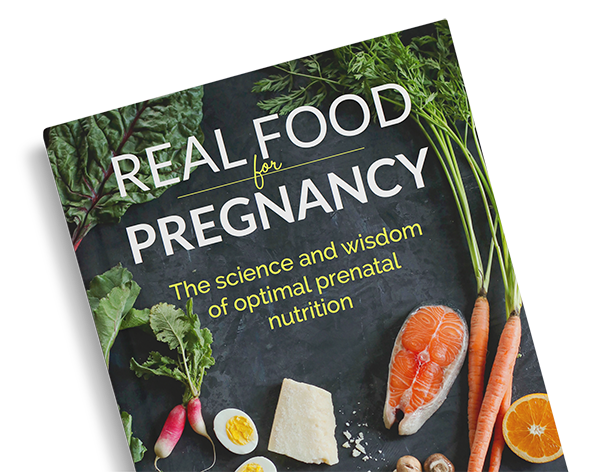
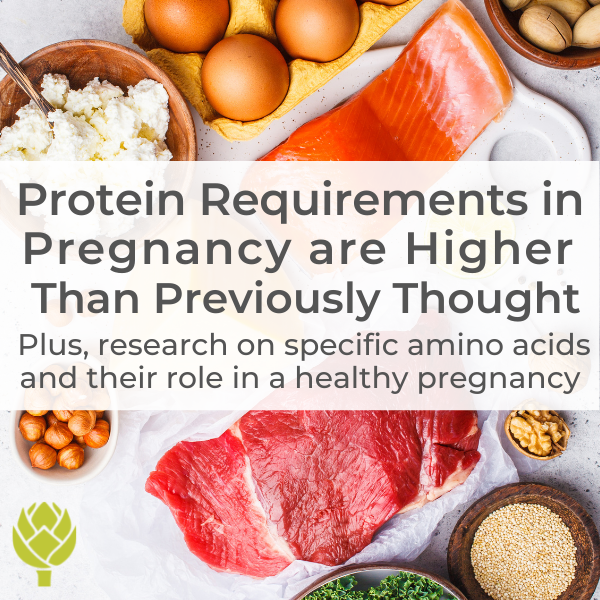
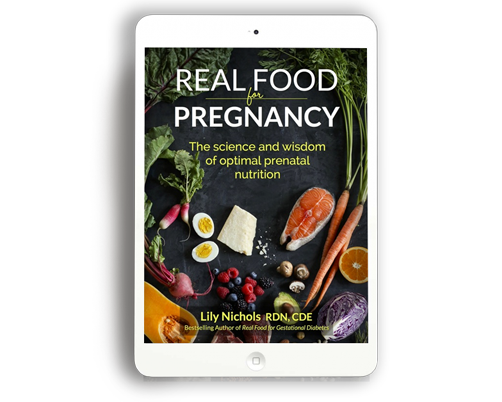
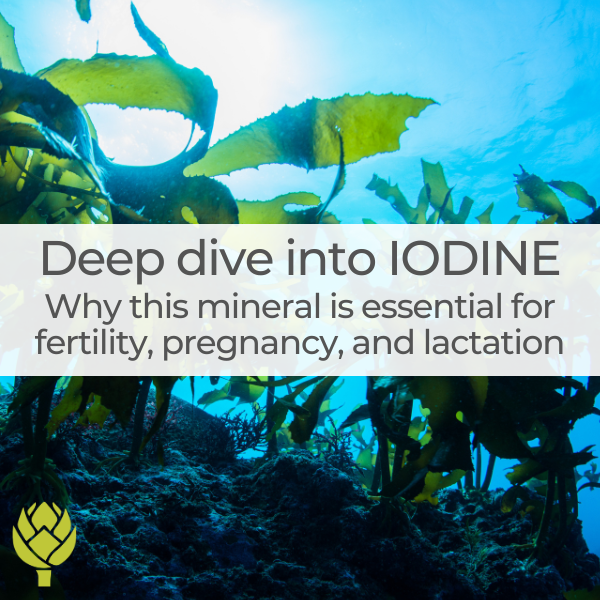

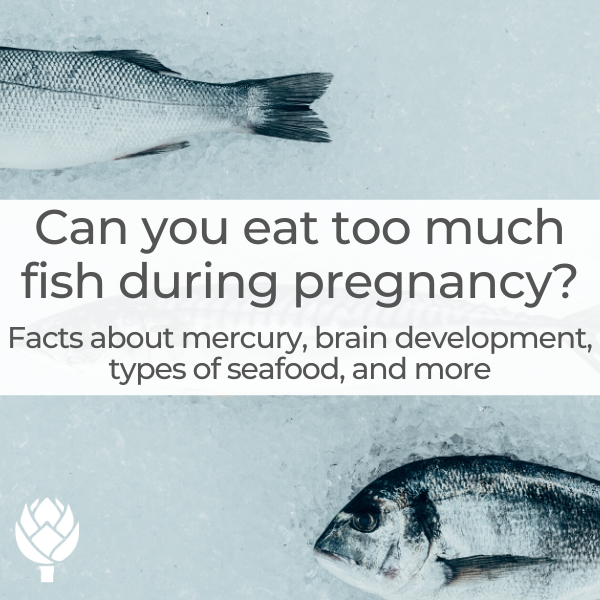
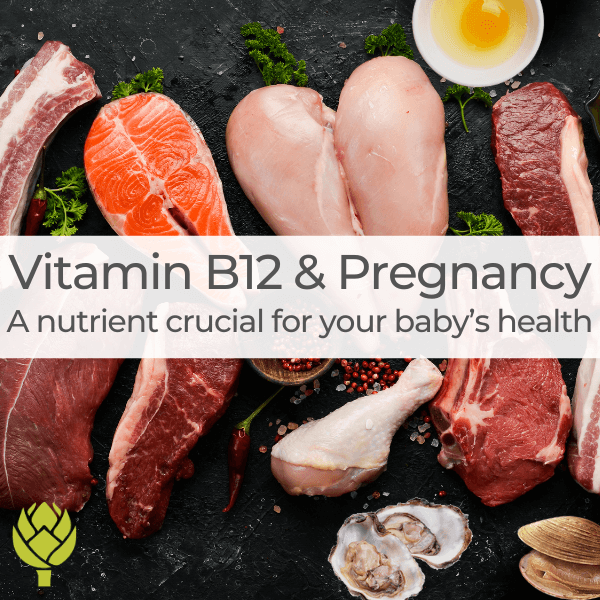

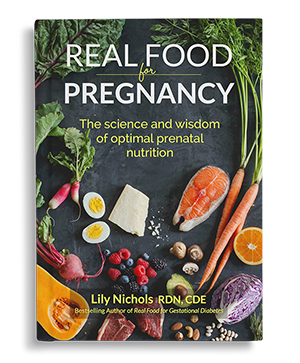
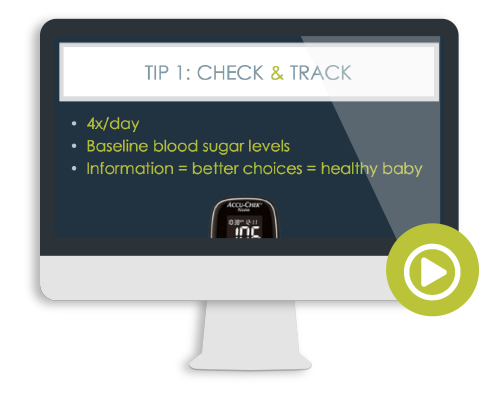
I’m 28 weeks pregnant with twins. Any thoughts on how my protein requirements would be different from what you mention in this article? Great article, by the way! I have your book (Real Food for Pregnancy) and a BS in nutrition. I think this stuff is just fascinating!
Great question. There have been some studies on twin pregnancy showing optimal outcomes with protein intake of 175g per day (for women who started their pregnancy in the healthy BMI range), but always consult your provider or dietitian for individualized advice.
Twin pregnancy nutrition is a topic I intend to expand upon once I launch my prenatal nutrition mentorship program for health professionals. Stay tuned.
Thank you so much for this comprehensive article on protein needs in pregnancy. I was just googling protein and pregnancy and found the advice conflicting. After reading this, I made a point to consume a higher protein breakfast today and it’s amazing how much better I feel. Thank you, Lily! I’ll be getting your book ASAP.
Glad the protein and pregnancy article was helpful to you, Anne!
If a woman is obese at the start of her pregnancy, should she still use the same calculation? My BMI is 45 and when I do the calculation, it gives me an astronomically high protein requirement for pregnancy.
Great question, Britt. Some recommend using what’s called an “adjusted body weight” or “ideal body weight” in the grams per body weight calculations in situations where the BMI is high to prevent over-estimation of protein needs. Another option is to calculate based on energy needs (calories) and a % of calories coming from protein, which can then be converted into a gram amount. I’d recommend working with a registered dietitian if you need individualized advice, as there’s a fair amount of clinical judgement that goes into calculating nutrient needs.
You are my favorite prenatal nutritionist to follow because you lay out the facts on everything so clearly. I’ve actually stopped following most of the prenatal accounts on social media, ironically including a lady that calls herself “prenatalnutritionist” because she doesn’t seem to know what she’s talking about (and I’ve seen her copy your information, like full sentences from your books in some of her posts, just FYI).
Anyways, thanks for the extra information about protein & pregnancy and the higher amino acid needs prenatally. I have your book, Real Food for Pregnancy, which is amazing, but I also love coming back to your blog for more information as you publish it. I so appreciate how giving you are in your free content. Most would push you into a $2k program to access this kind of content. You’re truly amazing. Thank you again.
Do you count just complete animalprotein or does all protein sources (like rice) count?
Thanks so much for the information! To clarify though, I know you say here “Plant foods — such as beans/legumes, nuts, and seeds — are incomplete proteins.” But I always thought edemame was a complete protein. Am I missing something about edemame or soy protein generally? Thanks!
Hello Lily,
I am 12 weeks along and I started my pregnancy overweight. I actually started 3lbs shy of being categorized as obese by BMI standards. Even though, I’m still 12 weeks away from my GD test, would you recommend I get your Real Foods for Pregnancy book or should I go ahead and get Real Food for Gestational Diabetes?
Thank you,
Ashley
I would get Real Food for Pregnancy. You can view the differences between the books and how to choose which one is right for you at the bottom of this page. https://lilynicholsrdn.com/books/
In short, Real Food for Gestational Diabetes is specifically for after getting a diagnosis of gestational diabetes. Real Food for Pregnancy is for everything prenatal nutrition, but it also covers prevention of gestational diabetes and testing options.
Thank you for the through info! My integrative medicine doctor recommended that I take an amino acid supplement (BodyHealth Perfect Amino) to help with nausea in the first trimester. I eat meat and eggs regularly but I don’t know if it will be enough as I get into my second and third trimesters. I find it’s hard to remember to take the supplement first thing in the morning when I’m starving (it’s supposed to be taken on an empty stomach). What’s your take on supplementing amino acids? This one includes Leucine, Valine, Isoleucine, Lysine HCl, Phenylalanine, Threonine, Methionine and Tryptophan.
I don’t see a need for a supplement if you’re able to eat a sufficient amount from food.
Hi Lily,
Over the years, I’ve gotten a lot of my protein from protein powders (not ideal, I’m realizing) and prior to conception I’ve been incorporating more animal proteins. I find it difficult for me to meet my specific protein requirements without supplementing with protein powder. Is there a protein powder that you recommend for women who need higher protein intake but struggle with meeting it through animal or other whole food sources?
Thank you for providing this content!
I have the same question!
Is there harm of too much protein? I was recently told by my endocrinologist (referred for abnormal GTT, did glucose monitoring that was mildly abnormal, not sufficient to dx GDM) that I was eating too much protein at 175g/day. I did this based off of RD recommendation with 150g carbs or less as target, and AVG 2400 calories for third trimester pregnancy. She suggested closer to 100g/day of protein. She also wanted me to restrict my fat, so now I’m not sure what to eat at all!
It’s theoretically possible but extremely rare. I’ve never encountered it in all of my years in prenatal nutrition. I address this concern specifically and all of your concerns on macronutrient amounts/ratios in the diet in Ch 2 of Real Food for Pregnancy!
Thank you for such an in-depth coverage of this topic. What I would love to see from you is an article assessing the recommendations in the Brewer’s diet. It is so pervasive in natural birth education, but as you hinted, only parts of it stand up to current evidence.
I also would love to know more about you opinion on the Brewer Diet, Lily!
I am almost 7 weeks and just the thought of these protein options makes me nauseaous. Is there any recommendations for ways to get protein in spite of the nauesa? Thanks!
Very informative article thanks. Can you clarify the amount of protein is 100g – us that per meal so 3 meals plus 2 snacks or per day? I’m 27 weeks now. Have been on aspirin to reduce preeclampsia risk. Can you point me to more resources on this please?
100 grams would be split across the day. If you don’t snack, that could be ~33g of protein per meal. If you snack, it could be 25 grams per 3 meals, and the remaining protein split between the snacks.
It is sometimes hard for me to meet the protein requirements just from food products so I have supplemented with a grass-fed whey protein that has some stevia for flavor, but no additional additives. Is it okay to supplement with protein powders during pregnancy?
Assuming clean ingredients and the brand is responsible about testing for contaminants (like heavy metals), a serving of protein powder a day should be no problem. Just ensure it is not displacing too much whole foods, as whole food sources of protein provide many vitamins and minerals that an isolated protein powder doesn’t have.
Do you have any recommendations of how we can track our protein (app/website) intake? I feel like I’ve increased my protein, but unsure if I’m getting enough.
Yes, check out Cronometer (no affiliation, you can use the free version).
When counting protein should I just count foods that I’m eating mainly for the protein or should I count everything? For example, if I eat a sandwich should I just count the protein from the meat and the cheese or should I also add in the protein I get from wheat bread?
Hi Lily, love your work. As a dietitian I am doing a pregnancy in nutrition course where they suggest maximum intake of protein at 25% of daily energy intake, and keeping fat under 35%.
With Gestational diabetes this would mean a lot of carbs…
I would love your view and comments on the below;
When I asked why too much protein is harmful this is what the specialist dietitian’s running the program reported.
“In summary
Low maternal intake can cause embryonic losses and IUGR. High protein intake can cause same. Low intake means there are less amino acids available to supply the placenta resulting in placental insufficiency and consequently IUGR. High protein intake is also linked to IUGR and can cause fetal or neonatal death due to ammonia toxicity.
1.2g/kg of body weight/day during early gestation and 1.52g/kg of body weight per day during late gestation. This is the equivalent to 14% of energy intake for early gestation and 17.5% of energy intake for late gestation.
What is considered high protein intake?
A 2018 study found maternal intake has an inverse U shaped relationship with fetal growth. It’s been shown that greater than 20% of energy as protein can decrease fetal growth. This would be considered excessive. Optimal intake is still unknown and current recommendations suggest 10-20% of total energy intake.
A 2022 study has highlighted the inconsistency of results when looking at optimal protein intake during pregnancy and found that 14.5% of total energy consumed as protein resulted in reduced risk for LBW, SGA and IUGR compared to women consuming protein at 8.3% of total energy. Among specific food sources of protein, higher protein intake from dairy during pregnancy was associated with higher birth weight and lower risks of LBW, SGA, and IUGR.”
Thanks for sharing and for your questions. None of this information on protein negates what is shared in this article. The study showing 1.22 and 1.52 g/kg represents the EAR, not the RDA. EAR’s meet approximately 50% of a population’s nutrient needs, while an RDA (which is always set higher) meets 97.5% of a population’s needs. From what we know right now from the research to date, optimal protein intake in pregnancy is likely 18-20% of calories. It’s nearly impossible to exceed 25% of calories from protein because it is so satiating. Some of the information she cites (ammonia toxicity) is from rat studies. Please see Ch 2 of Real Food for Pregnancy for more.
The information on so-called “optimal” macronutrient breakdown for gestational diabetes shows me that this professional doesn’t have much clinical experience with gestational diabetes. Optimal macronutrient ratios vary from client to client and need to be personalized. Please see Real Food for Gestational Diabetes for more.
For practitioners who want more information, the Institute for Prenatal Nutrition(TM) has detailed classes on macronutrients in pregnancy, gestational diabetes, and much more — all based on the latest research.
Thought on protein powder that contains sucrolose and xantham gum?
I recommend staying away from Splenda (sucralose). Pure protein powders that are unsweetened are my preference, if you’re not able to get in enough protein from whole foods, of course.